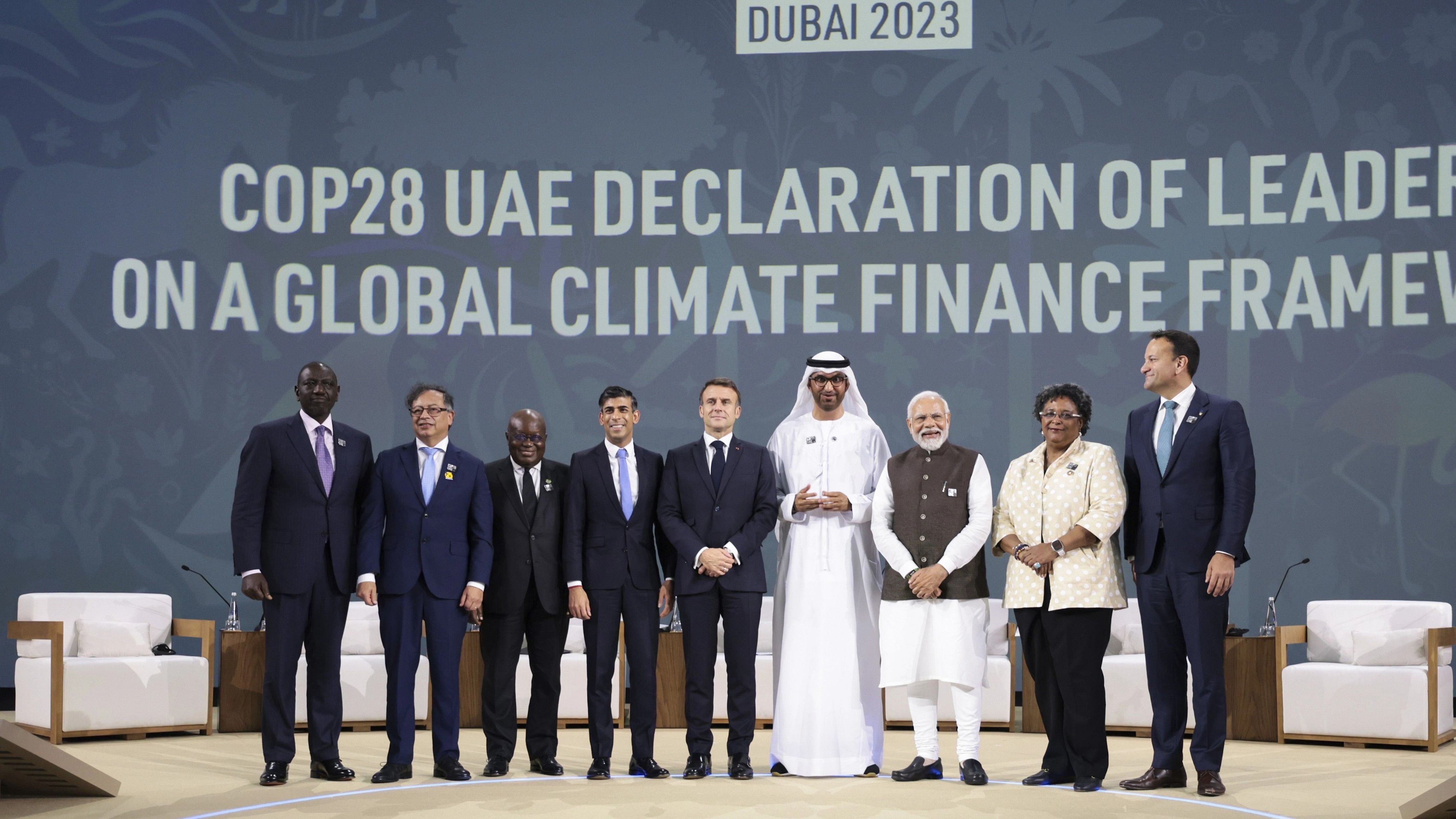
Prime Minister Narendra Modi with world leaders at a session on 'Transforming Climate Finance' during the COP28, in Dubai, UAE.
Credit: PTI Photo
Among the many distinctions that the Dubai Climate Conference may claim one would be that of being the first ever to host the Global Stock Take (GST) on Climate Change. As per the Paris Agreement whose implementation commenced in 2021, the first stocktake of the progress towards the global goal of climate stabilisation is to take place in 2023. The goal is to limit the planetary temperature rise below 2 or 1.5 degree as early as possible by reducing global emissions and taking steps to enhance adaptation and means of implementation. CoP 28 in Dubai marks a mid-term review of the impact of the actions taken under the first cycle of national commitments under the Agreement finalised in 2015.
Even before the CoP, a dialogue amongst parties to the Paris Agreement had been initiated to assess the gaps in the progress towards the global goal and persuade the countries to make more ambitious commitments in future cycles of commitments through what is technically known as nationally determined contributions (NDCs). The NDCs are supposed to cover all areas of mitigation, adaptation, and means of implementation. However, the attention is usually riveted to what happens to the global trajectory of emissions and what needs to be done to buck the trend.
Two recent reports released by the UNFCCC Secretariat give significant pointers in this regard. One is a report on the first Technical Dialogue of the parties on GST which confirms that the world is not on track to meet the global goal and that more actions are needed on all fronts. The other is a Synthesis Report of the latest NDCs of all countries which says that the global emissions in 2030 will be 8.8 per cent higher than in 2010 even if the projected total global GHG emissions are slated to peak sometime before 2030. This stands in stark contrast to the decision of the CoP 26 at Glasgow exhorting the international community to bring down the global emissions by 45 per cent compared to 2010 levels to achieve a net zero emissions goal by mid-century. The targeted 45 per cent reduction is a recommendation made in 2019 by the Intergovernmental Panel on Climate Change (IPCC) which had analysed the scenarios for reaching the global net zero goal in 2050. But the emission pathway to be taken by each country is hugely contested.
The Paris Agreement obliges the developed countries to take the lead in this regard. The evidence, however, points to the contrary. Barring a few exceptions in the northern European countries, most countries in the global north have either grown their emissions or not reduced in accordance with their share in the cumulative emissions which still stand collectively at over 60 per cent. It is felt that the net zero goal by 2050 is merely an attempt to divert attention from the more pressing need of reducing emissions now and shifting the global baseline of emission reduction. This is evident from the new estimates of global emissions being put out in various reports where the emissions reduction goal is referenced no longer to 1990 or even 2010 but 2019. This would put immense pressure on the countries in the global south whose available space for energy growth shrinks even as the global baseline of emissions shifts. It would therefore be interesting to watch how the GST discussions unfold in Dubai in terms of specific future obligations for mitigation.
One indication is available in the NDC synthesis report itself. The report suggests that developing countries should drop the conditional elements of their NDCs to help the global peaking of emissions before 2030. Conditional NDCs are implemented only if there is access to enhanced financial resources. This could mean that the global south may be required to peak its emissions faster without support from the rest of the world and make transitions with its own resources.
The global north has also been talking about the urgency of aligning the current NDCs with the long-term net zero goal and eventually increase of NDC targets for 2030. Simultaneously, the GST technical dialogue has emphasised the need to carry out systemic transformations across economic sectors. Most of the systemic transformations involve scaling up the renewable energy. The tripling of global renewable energy targets for 2030 which had been agreed by G20 could easily be the central piece of Dubai outcomes. But the implicit message is that the coal or oil dependent economies should also phase out unabated fossil fuels early through carbon capture technologies and coal phaseout. This is clearly a territory full of mines and has the potential of creating avoidable controversies.
There is growing demand in international circles that the global financial flows should be made consistent with the goal of greenhouse gas mitigation and climate resilience. In some extreme scenarios, the prospect of unlocking the trillions of dollars for climate finance is conditional to such a phaseout. On the other hand, adaptation financing is wished away by merely talking about adaptation planning, reporting and information building. The countries of the global south will need to speak in one voice to resist these attempts to change the principles of global finance in the name of fighting climate change.
Global Stocktake is an opportunity for the world to realise that setting long-term goals alone will not save the planet. The UAE Presidency will have its task cut out to ensure that there are balanced and equitable outcomes on global stocktake in Dubai and that both the short-term as well as long-term interests of all countries are taken into account in the next commitment cycle.
(The writer is a Distinguished Fellow at The Energy and Resources Institute and a former lead negotiator on climate change).